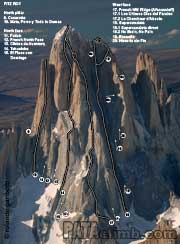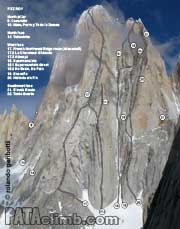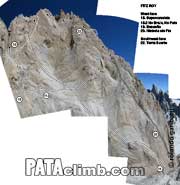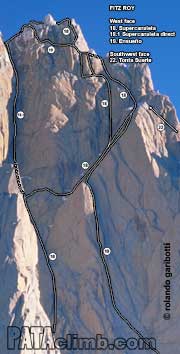Fitz Roy - West face
18. Supercanaleta
18.1 Supercanaleta Directa
18.2 No Brain No Pain
1600m 80˚ 5+
Carlos Comesaña and José Luis Fonrouge (Arg), 16/1/1965.
Description. A very obvious and elegant route, that technically is the easiest on the peak, but due to its length is quite serious. It climbs the prominent gash in the west face, which involves 1000 meters up an easy snow and ice gully followed by 15 pitches of moderate rock and mixed climbing. It funnels the falling debris from the adjacent walls, but in the right conditions –cooler weather- it is not overly dangerous. The most difficult climbing is concentrated in the last 200 meters of the route, which involve climbing several gendarmes along the west-southwest ridge.
Simul-climb or solo the couloir (35°-60°) for three to four hours to the base of the Bloque Empotrado (chockstone) that blocks the right fork of the couloir. It is best to reach this section in daylight for easier route finding. At this point do not follow the left fork of the couloir since it dead ends in featureless slabs. Climb to the top of the Bloque Empotrado via its right side (5 and 85°, 2-3 hrs). Climb the snowfield above and then traverse right via easy ledges (5+) for 60 meters to a shallow groove (if you traverse high you might have to make a short rap) and continue heading right on easy ground (4 and 5), then straight up to the ridgeline (2-3 hrs). From where you can see the Torres traverse horizontally left, to a short corner that leads to the ridge and the base of a gendarme that is climbed in two pitches (6a) on it’s north side (some fixed pins). Traverse under the south side of final tower and make a wild hand traverse and short rappel to the summit slope (3 hrs). Follow ice and easy rock to the summit (45 min).
18.1 Supercanaleta Directa.
In 1987 Franco Demarchi and Mosè Mercolli (Switzerland) climbed the 250-meter dihedral straight up above the Bloque Empotrado (6a/A2) to reach the summit slopes without traversing to the west-southwest ridge. They found poor quality rock. This line is the descent route. This direct variation was erroneously credited in many publications to Italians Ermanno Salvaterra, Elio Orlandi and Maurizio Giarolli.
History. Fonrouge and Comesaña, who were completely unknown outside their country, surprised the climbing world with such a bold and committing ascent, which was completed in three days round trip. Theirs was the second ascent of Fitz Roy. They were part of a bigger expedition that included Antonio Misson, Martín Dónovan and Jorge Ruiz Luque (Argentina). Carlos Botazzi and Otto Weisskopft (Italian and Austrian born Argentines), Teodoro Sifuentes and Anselmo Weber (Argentina) first attempted this line during the winter of 1962 and Botazzi and Weisskopft tried again two years later. On both occasions they reached the Bloque Empotrado. Until very recently it was the only route on Fitz Roy that was put up alpine style, without the use of fixed ropes. The first winter ascent was done by Argentines Eduardo Brenner, Sebastián De La Cruz and Gabriel Ruiz, over three days in July, 1986. De La Cruz and Ruiz suffered severe frostbite, with Ruiz requiring amputation. Brenner waited for his companions at the end of the difficulties and did not reach the summit. This was the first winter ascent of the peak. Since then, the route has seen three or four more winter ascents, including a female winter ascent by Erica Beuzenberg (New Zealand) in 1993. Solo ascent: in 2002 Dean Potter (USA) completed a solo ascent of the route in a mere 6.5 hours, descending the Franco-Argentine. Before his ascent there had been many solo attempts including Patrick Cordier (France) in 1973, John Bragg (USA) in 1978, Thierry Volpiatto (France) in 1983 and Andy Parkin (UK) in 1996. Only Volpiatto made it past the Bloque Empotrado but was forced to retreat when he was hit by rock fall. Car-to-car ascents, starting from the Río Eléctrico bridge and finishing in El Pilar: Colin Haley and Andy Wyatt 21:08hs 1/2016, the first time that Fitz Roy was climbed in a day round-trip; in 2014 Simon Gietl and Gerry Fiegl had done it in 31:30hs; in 2013 Ben Erdmann and Tomás Müller did it in 36hs; in early 2009, Jorge Ackermann, Tomy Aguilo and Milena Gomez had also done it in around 36 hs. All female ascent, in early 2020, Raphaela Haug, Laura Tiefenthaler, and Babsi Vigl did the first all female ascent of the route.
Notes. In 1987 Paul Gagner and Walt Shipley (USA) made the first traverse of the mountain, climbing the Supercanaleta and descending the French Route in just one day. In late 1973 Kevin Carroll (New Zealand) and Steve McAndrews (USA) lost their lives while attempting or completing the second ascent of the route. Their bodies were found in the snow at the base of the route. In 2002 Frank Van Herreghewe, a very well loved Chalten resident of Belgian and Andorran descent fell while attempting to solo the Californian route, and now lies in a ledge in the vicinity of the Bloque Empotrado.
Supposed. In the early 2000s, having just been freed from a Bolivian jail, Alain Mesili (France) reported to Englishman Yossi Brain that he and Ricardo Arzela (Spain) had climbed a new line on Fitz Roy back in 1970. He claimed they climbed the first 300 meters of the Supercanaleta then traversed left on to a side ramp, which they supposedly followed until the vicinity of the Bloque Empotrado. At that point they supposedly climbed up and left across a steep bulge to reach a series of crack systems and ramps near the NW ridge, climbing up the final headwall via steep cracks, in the general area of what Afanassieff and partners climbed in 1979. Mesili claimed they spent four days on the ascent and a fifth day descending the 1952 French route, accomplishing a traverse of the mountain. He also claimed they climbed free, using pitons only for protection. This was reported in High Magazine 196 p.17. There is no basis to believe Mesili’s claims. There is no record of a Basque climber by the name of Arzela ever existing. Also, a good friend of Mesili’s assures that they visited the Fitz Roy area together for the first time in the early 1980’s, making it clear that Mesili had never been there before then. It is unclear if Mesili tried to pull a joke on Brain, who had just published a guidebook to the Bolivian Andes, something that Mesili might have resented, or if the time spent in jail sent Mesili’s imagination on a little trip to the past.
Approach. Paso Cuadrado and Glaciar Fitz Roy Norte.
Gear. The first ascent party took 16 pitons, 2 wooden wedges, and 1 ice screw.
Descent. The preferred descent route is the Francesa. In case Supercanaleta has to be descended the rappel line starts from the notch between the last gendarme on the west-southwest ridge and the summit slope.
Bibliography.
Fonrouge: CAB 1967 p. 25-31; AAJ 1965 p.457-458; AAJ 1966 p. 75-80; La Montaña 7 p.14-15; La Montagne et Alpinisme 53 p.101; Alpinismus 1965/7 p.14-17; GHM 1965 p.3-4, p.36; Fonrouge J.L. (1999) Horizontes Verticales en la Patagonia, El Elefante Blanco, Buenos Aires (p.89-106).
Botazzi: Vea y Lea 401, p.33-40; CAB 1963 p.44-45 and CAB 1967 p.19-26.
Carroll: AAJ 1974 p.198-199.
De la Cruz: CAB-Revista 15 p. 28-29, p. 40-41, p. 52-53. |
Photos (click to enlarge)
 Fitz Roy north and west face 
Fitz Roy west face 
Fitz Roy west face 
Fitz Roy west face 
Fitz Roy west face |
18.2 No Brain, No Pain
400m 6b
Claudio Inselvini (Italy) and Michi Lerjen (Switzerland), 11/2007, to the summit slope.
Description. Inselvini and Lerjen climbed the initial gully of the Supercanaleta to the base of the Bloque Empotrado and from there traversed horizontally right for 200 meters, across a series of ledges and easy slabs, towards Fitz Roy’s WSW ridge, crossing Ensueño to reach the vicinity of the ridge itself. From here they climbed up, climbing six to eight pitches involving slabs and steep cracks on the north side of the ridge to reach the upper portion of Tonta Suerte along which they continued to join the upper ridge of Supercanaleta and eventually the easy summit slopes. This is a really interesting variation, one that would make more sense when combined with Ensueño, resulting in a very direct and beautiful link-up, which would involve climbing the first 20 pitches of Ensueño, to No Brain-No Pain, to Tonta Suerte, to Supercanaleta.
History. It was by mistake that they climbed this route, thinking they were repeating the Supercanaleta... At the summit slopes and in spite of being less than one hour of un-roped climbing away from the summit they decided to turn around. In the descent Inselvini got hit by rock fall right in his eye and had to be evacuated to Rio Gallegos.
|




